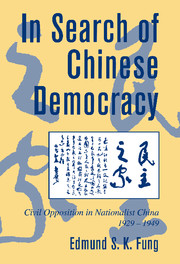Book contents
- Front Matter
- Contents
- Acknowledgments
- A Note on Romanization
- Abbreviations
- Introduction
- 1 The Dictatorial Regime
- 2 Setting the Opposition Agenda: The Issue of Human Rights, 1929–1931
- 3 The National Emergency, 1932–1936: Political and Intellectual Responses
- 4 In Defense of Democracy, 1933–1936
- 5 An Abortive Democratic Experiment: The People's Political Council, 1938–1945
- 6 Wartime Democratic Thought
- 7 The Third Force Movement: The Chinese Democratic League, 1941–1945
- 8 “Peace, Democracy, Unification, and Reconstruction,” 1946
- 9 The Last Stand of Chinese Liberalism
- Conclusion
- Selected Bibliography
- Glossary
- Index
7 - The Third Force Movement: The Chinese Democratic League, 1941–1945
Published online by Cambridge University Press: 22 September 2009
- Front Matter
- Contents
- Acknowledgments
- A Note on Romanization
- Abbreviations
- Introduction
- 1 The Dictatorial Regime
- 2 Setting the Opposition Agenda: The Issue of Human Rights, 1929–1931
- 3 The National Emergency, 1932–1936: Political and Intellectual Responses
- 4 In Defense of Democracy, 1933–1936
- 5 An Abortive Democratic Experiment: The People's Political Council, 1938–1945
- 6 Wartime Democratic Thought
- 7 The Third Force Movement: The Chinese Democratic League, 1941–1945
- 8 “Peace, Democracy, Unification, and Reconstruction,” 1946
- 9 The Last Stand of Chinese Liberalism
- Conclusion
- Selected Bibliography
- Glossary
- Index
Summary
Just one year into the First People's Political Council (PPC), the MPGs, frustrated at the renewed tension between the two major parties, were caught in the cross fire in a limited civil war. But, instead of ducking for cover, they took upon themselves a dual role as a mediator and a motor in the movement for democratic and constitutional change. Mediation was a difficult mission, but it was important for them because only reconciliation through negotiations could bring about China's unification, provide a framework for pluralist politics, and thereby ensure their own survival in the postwar period. Portraying themselves as a third force in Chinese politics, the MPGs' mission was to explore the possibility of a third road that was neither Nationalist nor Communist.
Earlier writers have employed the third force paradigm in a variety of ways. James Seymour has characterized the MPGs as “small middle parties” composed of middle-of-the-road intellectuals who sought to be “a liberalizing influence” but who were impotent through a lack of military power. Roger Jeans defines the third force in terms of opposition to both the Nationalists and the Communists, stressing the MPGs' attempts to offer political alternatives and their being caught in the cross fire between the major combatants. For Thomas Curran, the third force was “a loose coalition of intellectuals, educators, businessmen, and professional politicians dedicated to the introduction of democratic reforms and the maintenance of national unity in the interest of fighting the Japanese.”
- Type
- Chapter
- Information
- In Search of Chinese DemocracyCivil Opposition in Nationalist China, 1929–1949, pp. 230 - 262Publisher: Cambridge University PressPrint publication year: 2000
- 1
- Cited by



